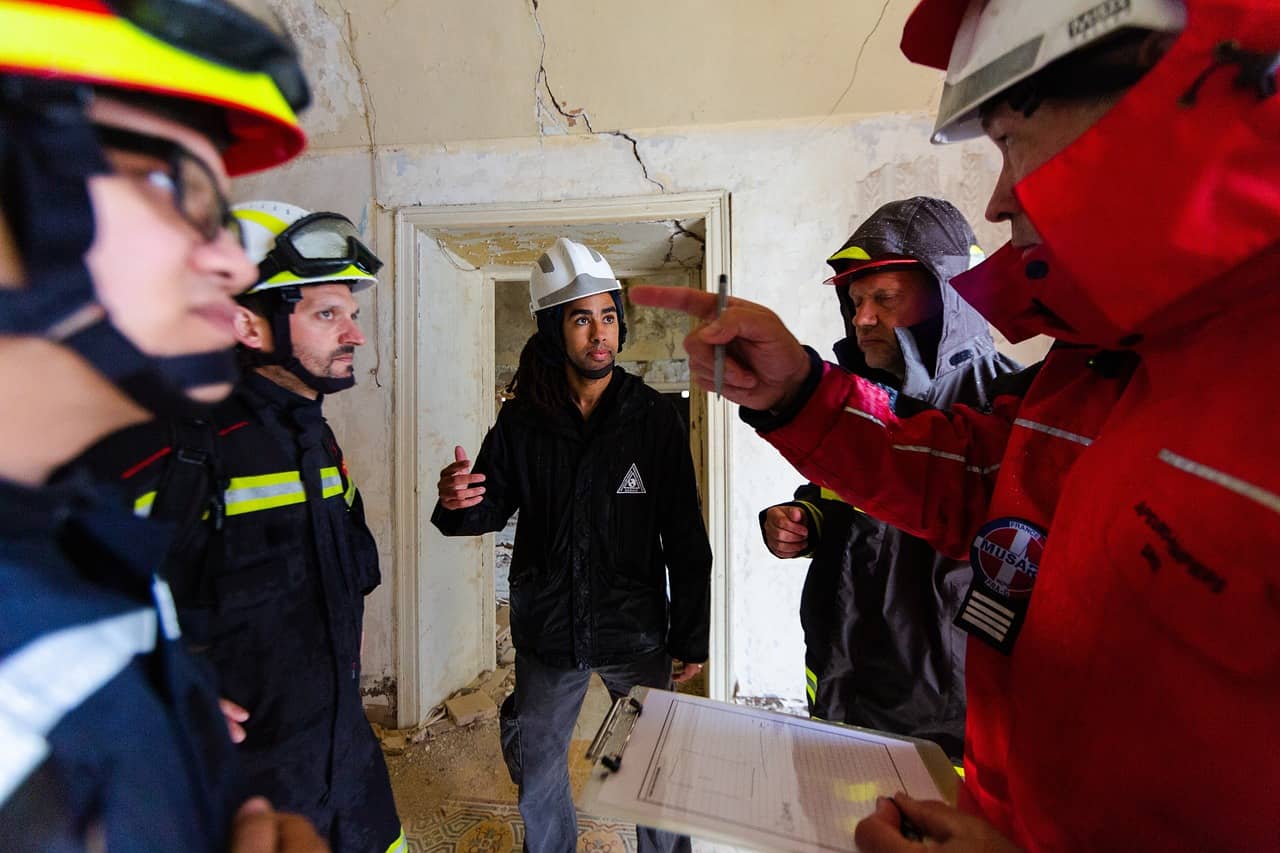Abrasive wheels are used in a wide range of industries and workplaces for cutting, grinding, and polishing materials. While they are essential for many tasks, they can also pose significant risks to workers if they are not used or maintained properly. Similarly, using abrasive wheels comes with a lot of hazards, and if you are using one in the course of your work, then you need to make sure that all the appropriate safety measures are taken.

According to the Health and Safety Executive (HSE), there were 186 reported accidents involving abrasive wheels in the UK in 2020, including 39 major injuries such as amputations, fractures, and dislocations. As you may be aware by now as to how many risks abrasive wheels pose, it is important that you carry out some safety measures before using one. In this blog post, we’ll outline the steps to follow when conducting an abrasive wheels risk assessment.
Legal and regulatory framework
There are several legal and regulatory requirements that employers must comply with when using abrasive wheels. The Health and Safety at Work etc. Act 1974 places a legal duty on employers to ensure the health, safety, and welfare of their employees. The Provision and Use of Work Equipment Regulations 1998 (PUWER) require that all work equipment is maintained, inspected, and suitable for the task. The Control of Substances Hazardous to Health Regulations 2002 (COSHH) requires employers to assess the risks associated with hazardous substances, including dust and fumes generated by abrasive wheels. Employers must also provide adequate training and supervision for workers who use abrasive wheels.
Hazards and risks associated with abrasive wheels
There are numerous hazards that are associated with abrasive wheels, such as flying debris, noise, vibration, and contact with the wheel itself. While working with abrasive wheels, workers are exposed to hazardous substances, such as silica dust, which can impact their lungs when inhaled. Injuries caused by abrasive wheels can range from minor cuts and bruises to more severe injuries, such as amputations and blindness.
Why is risk assessment essential when using abrasive wheels?
Carelessness, improper safety measures, and poor management while handling abrasive wheels can lead to fatalities, injuries, and serious damage to property and businesses. It is important that an employer analyze the hazardous nature of these activities and take appropriate action to mitigate the risks.
All risk assessments dealing with abrasive wheels should be carried out in a precise and methodical manner. The aim of risk assessment is to identify any potential hazards and implement safety procedures to eliminate these risks.
However, conducting a risk assessment is not as easy as it might seem. Risk assessments vary for different types of hazards, and it is quite possible for a person to not carry out a risk assessment properly if they don’t have the required knowledge. Therefore, professionals recommend taking educational courses like risk assessment training that will educate you on how you can effectively carry out a risk assessment by understanding the risks and figuring out who might be at risk of these threats. These courses also teach you how you can plan out control measures for each risk associated with your hazard.
The five steps of abrasive wheel risk assessments
There are five main steps involved in conducting an effective abrasive wheel risk assessment:
- Identify the hazards
- Decide who might be harmed and how
- Evaluate the risks and decide on precautions
- Record your findings and implement them
- Review your risk assessment and update it if necessary
Step One: Identifying the hazards
The first stage of the risk assessment is to analyze your workplace and identify the hazards. Abrasive wheel operates at very high speeds, and such high speeds can create mechanical hazards. Here are some of the hazards you need to be aware of when operating abrasive wheels:
- Mechanical Hazards
- Electricity
- Fire and Heat
- Dust
- Noise
- Vibration
On moving parts of the abrasive wheel, your loose clothing or jewellery can get caught. Flying debris or pieces splintering from a broken or defective wheel can cause impact injuries. Additionally, there is a chance of the workpiece itself being broken and may move or be ejected. Additionally, unintentional slips or abrupt movements can result in cuts and abrasions from coming into contact with the wheel.
Combustibles around your workplace can easily catch on fire when they come in contact with the sparks or hot particles generated from abrasive wheel activities like cutting, welding, or grinding. On occasion, heat can cause a fire to start when it passes through conductive materials like steel or metal pipework and comes into contact with combustible materials. Additionally, after hot work has been finished, fires can happen. During the activity, sparks from the activity may land on combustible materials, where they may smoulder for a long time before igniting.
Step Two: Who might be harmed and how?
When considering who might be harmed by the abrasive wheel, it is important to take note that not only the operators are at risk. Abrasive wheels can be hazardous for nearby people in the workplace. High levels of noise and dust can have a harmful impact on the ears and lungs of the bystanders. Broken wheels or flying debris can result in workers being injured or nearby equipment being damaged.
Step Three: Evaluating the risks and deciding on precautions
Any job involving abrasive wheels carries a sizable risk of injury. Even though every workplace is unique, there are some abrasive wheel safety precautions that should always be followed.
These measures for precautions include:
- Drawing in hazards: Operators should not wear loose clothing or jewelry when working with abrasive wheels. The worker’s hair, clothing, and gloves must be kept away from moving parts.
- Accidental contact: While operating the abrasive wheel, operators should be in a stable and balanced position. Their footing should be stable and strong so that the chances of slipping remain minimal. Machine guards can provide extra security; hence, they should always be present. Operators should be aware of the risks of vibrations and figure injuries.
- Handle kickback and slippage: Auxiliary handles can significantly help in having maximum control over torque reaction or kickback.
- Wheel breakage: The operator should make sure that they are using the correct type of abrasive wheel to cut into an object. Additionally, the operator should inspect the wheel to ensure that it is in good condition.
- Faults: Only trained personnel should replace wheels and blades. Before each use, the operator should inspect wheels and blades.
- Flying debris: The work area should be fenced off to prevent bystanders from being hit by flying debris.
- Fire: The availability of fire extinguisher is a must in those workplaces where abrasive wheels are being used, and the operator should remove all the flammable materials from the workplace so that the chances of fire remains slim.
- Emergencies: An assistant should be available to tell the operator if alarms, sirens, or other types of warnings are alerted.
- Adequate training: Only workers who have undertaken abrasive wheel training should be allowed to work with abrasive wheels. Training ensures that the worker is competent enough to handle tasks related to abrasive wheels.
- Personal protective equipment (PPE): Employers should provide the operators with appropriate PPE, such as face protection, gloves, and safety shoes.
Step Four: Record keeping
A detailed record of all your findings related to the risks and threats, as well as the safety procedures implemented, should be made. This would also help in assuring your compliance with health and safety regulations.
Notes should be made on the following:
- Hazards that were identified
- Who may be harmed by these hazards?
- What steps are taken to eliminate or reduce these risks
Step Five: Reviewing your risk assessment and update if required
Reviewing your risk assessment is an important process and must be done annually. Suppose the workplace has undergone changes, such as new procedures or no equipment. In that case, the risk assessment should be re-conducted.
Conclusion
Conducting an abrasive wheel risk assessment is crucial to ensure the safety of workers who use abrasive wheels in various industries and workplaces. By identifying the hazards and assessing the risks associated with abrasive wheels, employers can implement appropriate control measures to reduce the risks to an acceptable level. This includes eliminating or reducing the hazard, providing suitable personal protective equipment (PPE), and ensuring that workers are adequately trained and supervised. Remember to keep records of risk assessments and review them regularly to ensure that they remain up-to-date. By following these steps, employers can help to prevent accidents and injuries in the workplace and ensure the health and safety of their employees.
Also read: 7 Common Construction Estimating Mistakes


Leave a comment